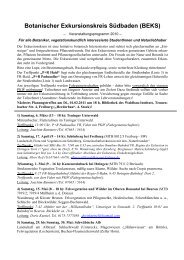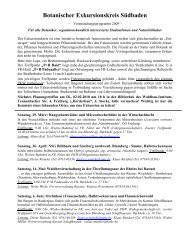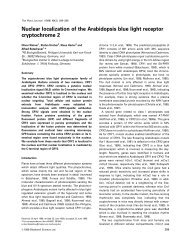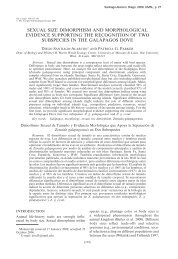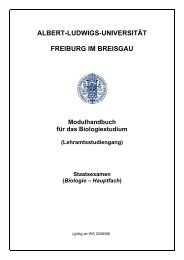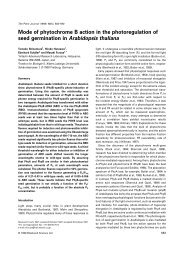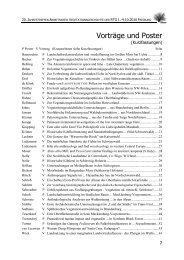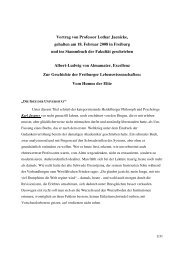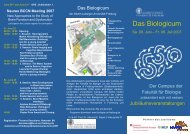Light-controlled growth of the maize seedling mesocotyl: Mechanical ...
Light-controlled growth of the maize seedling mesocotyl: Mechanical ...
Light-controlled growth of the maize seedling mesocotyl: Mechanical ...
You also want an ePaper? Increase the reach of your titles
YUMPU automatically turns print PDFs into web optimized ePapers that Google loves.
Fig. 9. Spatial distribution <strong>of</strong> MEZ elongation in<br />
<strong>maize</strong> <strong>seedling</strong>s in darkness following a 3-h<br />
irradiation with blue light. The MEZ was<br />
subdivided by ink marks in five 2-mm sections at<br />
<strong>the</strong> end <strong>of</strong> <strong>the</strong> light treatment (left). The<br />
extension <strong>of</strong> <strong>the</strong>se sections was determined<br />
during <strong>the</strong> following dark period starting at 9 h<br />
after <strong>the</strong> onset <strong>of</strong> light (cf. Fig. 1). Data points<br />
represent means (SE) from 30 to 50 <strong>seedling</strong>s.<br />
The shaded area marks <strong>the</strong> fraction <strong>of</strong> original<br />
MEZ tissue leaving <strong>the</strong> 10-mm region below <strong>the</strong><br />
node. The changes in distance between ink<br />
marks in a representative <strong>mesocotyl</strong> are shown<br />
on <strong>the</strong> right. The insert shows <strong>the</strong> calulated loss<br />
<strong>of</strong> original MEZ material caused by this <strong>growth</strong><br />
process and <strong>the</strong> concomitant loss <strong>of</strong> light-induced<br />
lignin from <strong>the</strong> MEZ (Fig. 8b).<br />
General conclusions<br />
The idea that elongation <strong>growth</strong> <strong>of</strong> plant cells can be<br />
<strong>controlled</strong> by <strong>the</strong> formation <strong>of</strong> lignin, cross-linked to<br />
hemicelluloses in primary walls, was first expressed by<br />
Whitmore (1971). The existence <strong>of</strong> a cell-wall-stiffening reaction<br />
in potentially growing plant tissues has been deduced<br />
previously from physiological experiments with<br />
<strong>maize</strong> coleoptiles (Hohl et al. 1995) and related in-vitro<br />
measurements <strong>of</strong> mechanical cell-wall properties (Schopfer<br />
1996). It emerged from <strong>the</strong>se investigations that cell-wall<br />
stiffening is a metabolically <strong>controlled</strong> reaction and fulfills<br />
criteria <strong>of</strong> a peroxidase-catalyzed, H 2O 2-dependent phenolic<br />
cross-linking reaction. The present paper pertains to<br />
<strong>the</strong> molecular identification <strong>of</strong> <strong>the</strong> cross-linking material in<br />
<strong>the</strong> cell wall and its involvement in <strong>the</strong> control <strong>of</strong> extension<br />
<strong>growth</strong>. Taken toge<strong>the</strong>r, our data demonstrate a<br />
fairly good correlation between inhibition <strong>of</strong> elongation<br />
<strong>growth</strong>, increase in cell-wall stiffness and incorporation <strong>of</strong><br />
lignin in <strong>the</strong> <strong>growth</strong>-controlling outer tissues <strong>of</strong> <strong>the</strong> MEZ<br />
<strong>of</strong> <strong>maize</strong> <strong>mesocotyl</strong>s, suggesting a causal relationship between<br />
<strong>the</strong>se light-induced events. However, it may be premature<br />
to conclude from <strong>the</strong>se results that <strong>the</strong><br />
incorporation <strong>of</strong> lignin in <strong>growth</strong>-limiting cell walls is generally<br />
responsible for <strong>the</strong> control <strong>of</strong> cell extension, and to<br />
disregard o<strong>the</strong>r potentially <strong>growth</strong>-controlling changes in<br />
mechanical wall properties. We have been unable, for in-<br />
stance, to detect any appreciable effects <strong>of</strong> <strong>growth</strong>-promoting<br />
auxin treatments on lignin content <strong>of</strong> <strong>the</strong> MEZ in<br />
<strong>the</strong> <strong>maize</strong> <strong>mesocotyl</strong> (data not shown). In this context, it<br />
is interesting to note that <strong>the</strong> biophysical analysis <strong>of</strong> <strong>the</strong><br />
rapid <strong>growth</strong> suppression by blue light in cucumber and<br />
pea <strong>seedling</strong>s has led to disagreeing results. In cucumber<br />
hypocotyl segments, irradiation induced a decrease in cellwall<br />
yielding in vivo without significantly changing <strong>the</strong><br />
extensibility <strong>of</strong> <strong>the</strong> isolated walls as measured by stress/<br />
strain (Instron) analysis (Cosgrove 1988). Under similar<br />
experimental conditions, pea epicotyl segments demonstrated<br />
a decrease in cell-wall yielding in vivo that was<br />
accompanied by a decrease in wall extensibility in vitro<br />
(Kigel and Cosgrove 1991). In summary, our findings support<br />
<strong>the</strong> concept proposed previously (Hohl et al. 1995)<br />
that cell extension in plant organs depends on <strong>the</strong> balance<br />
<strong>of</strong> antagonizing wall-loosening and wall-stiffening reactions<br />
that can be independently regulated by different<br />
physiological <strong>growth</strong> factors such as photomorphogenetic<br />
light or <strong>growth</strong>-promoting hormones. Lignin-mediated<br />
cell-wall stiffening may be just one <strong>of</strong> several mechanisms<br />
affecting <strong>the</strong> mechanical cell-wall properties involved in<br />
<strong>the</strong> regulation <strong>of</strong> extension <strong>growth</strong> in plant cells.<br />
Acknowledgements – Supported by Deutsche Forschungsgemeinschaft.<br />
We thank Jasmin Hänßler for expert technical assistance,<br />
Brigitte Pollet for running <strong>the</strong> thioacidolysis experiments and<br />
Gabriele Biehle for introduction into Instron measurements.<br />
Physiol. Plant. 111, 2001 91




